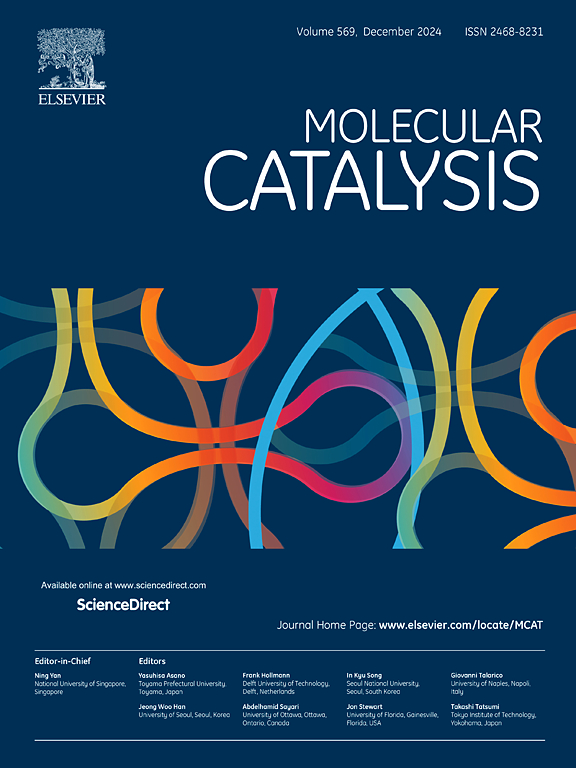工程扁桃酸脱氢酶高效生物合成丹丹酸A
IF 3.9
2区 化学
Q2 CHEMISTRY, PHYSICAL
引用次数: 0
摘要
丹参酸A (Salvianic acid A, SAA)是一种从丹参中提取的生物活性化合物,因其抗肿瘤和抗氧化活性而受到广泛关注。然而,传统的生产方法主要依靠物理提取和化学合成,限制了其大规模应用。本研究通过将大肠杆菌中4-羟基苯基乙酸3-单加氧酶HPPA羟基化模块HpaBC和graminis红酵母中d -杏仁酸脱氢酶DHPPA还原酶模块RgMDH整合到高产酪氨酸生产菌株Tyr0中,构建了SAA的全新生物合成途径,生成工程菌株Dps01。代谢分析发现RgMDH催化效率低是关键瓶颈。为了解决这个问题,我们对RgMDH进行了结构引导蛋白工程。分子动力学(MD)模拟显示,与野生型相比,最佳突变体RgMDHM4 (T312A/F316S/T255I/A59H)的催化构象占用率提高了10.3倍(4.74%比0.46%),表明底物通道动力学增强。该突变体对DHPPA的活性增加了295%,对底物的亲和力增强,催化效率(kcat/Km)提高了5.76倍。集成到应变Dps02时,设计系统实现了最大SAA 34小时内生产6.82 g / L,效率为0.21 g / L·h⁻¹5 L馈料式发酵。这些结果代表了SAA生物合成的重大进展。本文章由计算机程序翻译,如有差异,请以英文原文为准。

Engineering mandelate dehydrogenase for the efficient biosynthesis of salvianic acid A
Salvianic acid A (SAA), a bioactive compound from Salvia miltiorrhiza, has attracted significant attention for its therapeutic properties, including antitumor and antioxidant activities. However, its large-scale application is limited by the conventional production methods, which rely primarily on physical extraction and chemical synthesis. In this study, we constructed a de novo biosynthetic pathway for SAA by integrating two key modules: the HPPA hydroxylation module HpaBC (4-hydroxyphenylacetate 3-monooxygenase from Escherichia coli) and the DHPPA reductase module RgMDH (D-mandelic acid dehydrogenase from Rhodotorula graminis) into a high-yield tyrosine-producing strain, Tyr0, generating the engineered strain Dps01. Metabolic analysis identified the low catalytic efficiency of RgMDH as the critical bottleneck. To address this, structure-guided protein engineering of RgMDH was performed. Molecular dynamics (MD) simulations revealed that the optimal mutant RgMDHM4 (T312A/F316S/T255I/A59H) exhibited a 10.3-fold increase in catalytic conformation occupancy compared to the wild-type (4.74% vs 0.46%), indicating enhanced substrate channel dynamics. This mutant exhibited a 295% increase in activity toward DHPPA, with enhanced substrate affinity and a 5.76-fold improvement in catalytic efficiency (kcat/Km). When integrated into strain Dps02, the engineered system achieved a maximum SAA production of 6.82 g/L within 34 hours, with a productivity of 0.21 g/L·h⁻¹ in a 5 L fed-batch fermentation. These results represent a significant advancement in the biosynthesis of SAA.
求助全文
通过发布文献求助,成功后即可免费获取论文全文。
去求助
来源期刊

Molecular Catalysis
Chemical Engineering-Process Chemistry and Technology
CiteScore
6.90
自引率
10.90%
发文量
700
审稿时长
40 days
期刊介绍:
Molecular Catalysis publishes full papers that are original, rigorous, and scholarly contributions examining the molecular and atomic aspects of catalytic activation and reaction mechanisms. The fields covered are:
Heterogeneous catalysis including immobilized molecular catalysts
Homogeneous catalysis including organocatalysis, organometallic catalysis and biocatalysis
Photo- and electrochemistry
Theoretical aspects of catalysis analyzed by computational methods
 求助内容:
求助内容: 应助结果提醒方式:
应助结果提醒方式:


